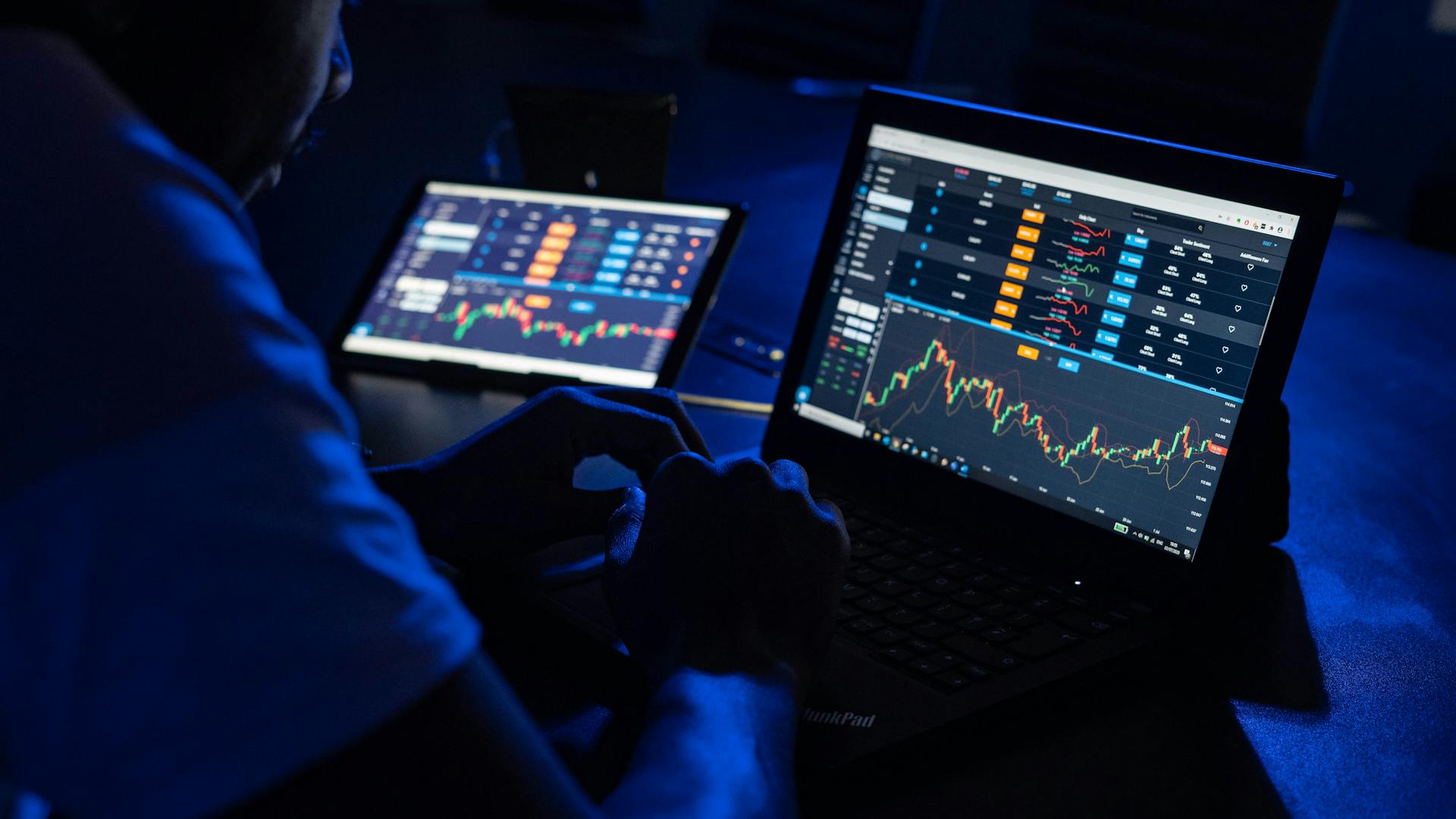
A spot contract is a type of financial agreement where the buyer and seller agree to exchange goods or currencies at the current market price.
The buyer and seller agree to the exchange at the current market price, eliminating the need for a future delivery date or price.
This type of contract is often used in the foreign exchange market, where traders buy and sell currencies at the current market rate.
Spot contracts are typically settled on the same day or within two business days.
For more insights, see: Debt Buyer (United States)
What is a Spot Contract?
A spot contract is a standardized, transferable legal agreement to make or take delivery of a specified amount of a certain commodity, currency, or asset at the current date.
The price is determined when the agreement is made, and it's determined to be delivered at the current date, which is the main difference between spots and futures.
Spot contracts frequently settle in cash instead of actual physical delivery of the asset traded, but with some small differences.
For your interest: What Is the Difference between a Contract and an Agreement
Trading a currency spot contract is a form of Forex trading, which means it's a way to buy and sell currencies on the foreign exchange market.
Spot markets trade commodities or other assets for immediate (or very near-term) delivery, and the word spot refers to the trade and receipt of the asset being made on the spot.
Worth a look: Trade Futures Contracts
How Spot Contracts Work
A spot contract is created by tracking the spot price of an asset, allowing you to take a position on the most recent buy and sell orders of market participants. This means you can enter a spot contract at a price level you're comfortable with and be part of a binding agreement to exchange the asset immediately or settle in cash.
The spot price usually changes much faster than futures or options markets, especially in liquid markets where there are a high number of market participants making bids and offers. Fast-changing rates can impact your trade, as it could be executed at a different price from the one you requested – known as negative slippage.
For your interest: Asset Trading

To prevent slippage, you can attach a guaranteed stop loss to your position, which will ensure your trade is always placed at the level you've chosen. There is no fee to attach the stop, but if it is triggered, you would incur a small premium.
Here's a breakdown of the process of creating a spot contract:
- Create an account and log in
- Search for the market you'd like to trade (e.g. 'gold')
- Select 'spot' at the top of the deal ticket in the right-hand panel
- Decide whether to 'buy' or 'sell' the spot market
- Choose your trade size and open your first position
Trading Mechanism
The trading mechanism of spot contracts is based on the economic process of supply and demand. This means that the price of a spot contract is determined by the interactions of buyers and sellers in the market.
The spot price, also known as the spot rate, is the going price for a trade executed on the spot. It's determined by the last price, bid, and ask, and is available on all currency and commodity markets.
In a liquid market, the spot price can change rapidly, sometimes even within milliseconds. This can impact your trade, especially if you're not prepared for it. To mitigate this risk, you can attach a guaranteed stop loss to your position, which will ensure your trade is executed at the level you've chosen.
Curious to learn more? Check out: How Are Spot Exchange Rates Determined
The spot price is largely a product of the supply and demand function, unlike the forward price, which is influenced by factors such as the time value of money, yield curve, and storage costs.
In summary, the trading mechanism of spot contracts is a dynamic and fast-paced process that's driven by the interactions of buyers and sellers in the market.
Here's a breakdown of the key factors that influence the spot price:
Example
Spot contracts are a type of financial instrument that allows you to buy or sell an underlying asset, such as gold or currency, at the current market price. You can use spot contracts to speculate on price movements or take physical delivery of the asset.
For example, if you believe the price of gold is going to rise, you can open a spread bet on the spot price and buy the market at £30 per point of movement. This means you'd pay £2100.45 to open a position, and if the price increases, you can close your position and take a profit of £1482.
Discover more: How to Buy Gold at Spot

Spot markets are active in various commodities, including gold, foreign exchange, and stocks. You can buy and sell shares of companies in real-time, and delivery usually occurs within two days after execution.
There are two ways to trade spot contracts: you can either take delivery of the underlying asset or hold onto the contract and sell it later. For instance, if you buy gold at a spot price of $1000, you can either take physical delivery of the gold or hold onto the contract and sell it later.
Here's a comparison of the two approaches:
Spot contracts can be used for immediate delivery of the underlying asset, as seen in the example of buying gold at the current market price of $1400. You can pay $1400 for the position and receive delivery the next day – unless you decide to settle in cash.
In foreign exchange, spot contracts are used for currency trades, which can be done through the banking system with electronic delivery of the currency bought. When you enter a spot contract, you'll typically pay the current market price, and delivery will occur within two days after execution.
Advantages and Disadvantages
Spot contract markets have several advantages that make them attractive to traders. Spot markets are incredibly liquid and active, with commodity producers and consumers actively engaging in them.
This liquidity is due in part to the fact that spot markets are based on the current quote for immediate purchase, payment, and delivery of a commodity. This transparency makes it easier to execute spot market contracts.
Spot market trades are done and completed on the spot, with no need for lengthy negotiations or follow-up. This can be a huge advantage for traders who need to act quickly.
Here are some key benefits of spot markets:
- Spot markets facilitate trading in a transparent environment.
- Traders can hold and find a better deal if they are not satisfied with current prices and terms.
- Trades are done and completed on the spot.
- There may be no minimum capital requirements in spot market transactions.
One of the benefits of spot markets is that traders can hold onto their contracts if they're not satisfied with the current prices and terms. This flexibility is a major advantage over other types of contracts.
Advantages
Spot markets are incredibly important because the spot price is the current quote for immediate purchase, payment, and delivery of a commodity.
This means that prices in derivatives markets, such as futures and options, will be based on these values. Spot markets are also incredibly liquid and active for this reason, with commodity producers and consumers engaging in the spot market and then hedging in the derivatives market.
Spot markets facilitate trading in a transparent environment, where transactions occur at prevailing prices that are public information and known to all parties.
Traders in spot markets can hold and find a better deal if they are not satisfied with current prices and terms. Trades are done and completed on the spot, which is a significant advantage.
Here are some key benefits of spot markets:
- Trades are done and completed on the spot.
- There may be no minimum capital requirements in spot market transactions.
- Traders can hold and find a better deal if they are not satisfied with current prices and terms.
- Transactions occur in a transparent environment, with prevailing prices public information.
Disadvantages
Taking delivery of a physical commodity can be a major hassle, especially if you're not prepared for it. For example, if you buy spot pork bellies, you'll end up owning some live hogs.
Spot markets can't be used to hedge against future production or consumption of goods, which can be a problem if you're trying to manage risk. This is where derivatives markets come in, but they're not suitable for spot markets.
You might enjoy: Capital Markets and Investments

Some spot markets are prone to volatility, which can lead to inflated prices that may not reflect the true value of the asset. This can be a significant risk for investors, especially when dealing with volatile assets.
Spot market trades often lack planning, unlike forwards and futures trading where parties agree on settlement and delivery at a future date.
The spot market can be inflexible in terms of timing, requiring parties to handle physical delivery immediately.
Spot Contract Trading
Spot Contract Trading is a type of trading where you can take a position on the most recent buy and sell orders of market participants, tracking the spot price of an asset.
The spot price is determined by buyers and sellers through an economic process of supply and demand, and is largely a product of the supply and demand function. It's not influenced by the time value of money, yield curve, and/or storage costs like forward prices are.
To trade spot contracts, you can create an account, log in, and search for the market you'd like to trade, then select 'spot' at the top of the deal ticket. You can also decide to 'buy' or 'sell' the spot market, choose your trade size, and open your first position.
Spot contracts can be traded using spread bets and CFDs, which allow you to speculate on the underlying market price of the asset without physically settling the exchange. This means you'll never have to physically settle the exchange, and you can use leverage to get full market exposure for just a small initial deposit, called margin.
Here are some key details to consider when trading spot contracts:
- Spot prices usually change much faster than futures or options markets, especially in liquid markets.
- You can attach a guaranteed stop loss to your position to prevent slippage, but if it is triggered, you would incur a small premium.
- Spot prices are available on all of our currency and commodity markets, as well as our German Bund government bond market.
Order Types
When trading Spot contracts, it's essential to understand the different order types available.
We only support market orders for Spot contracts. This means you can't place limit orders or other types of orders, so it's crucial to be prepared to execute trades at the current market price.
You might enjoy: Types of Private Investment Funds
Spot contracts are traded on a continuous market, meaning prices are constantly changing. This dynamic environment requires traders to be agile and responsive to market movements.
Market orders allow you to buy or sell at the current market price, which can be beneficial in fast-moving markets. However, it's essential to understand that market orders can be executed at any price, including prices that are unfavorable to you.
Recommended read: Gold and Silver Prices Today in Usa
How to Trade
Trading spot contracts can seem daunting, but with the right tools and knowledge, you can navigate the process with ease. To start, you'll need to create an account and log in to access the spot market.
You can search for the market you'd like to trade, such as gold, and select 'spot' at the top of the deal ticket in the right-hand panel. This will give you access to the current spot price.
To trade spot prices, you'll need to decide whether to 'buy' or 'sell' the spot market. You can choose your trade size and open your first position, or you can practice trading spot contracts in a risk-free environment first by creating a demo account.
Worth a look: Access Bank Nigeria Stock Price

One thing to note is that spot prices usually change much faster than futures or options markets, especially in liquid markets. To prevent slippage, you can attach a guaranteed stop loss to your position, which will ensure your trade is always placed at the level you've chosen.
Here's a step-by-step guide to trading spot contracts:
- Create an account and log in
- Search for the market you'd like to trade
- Select 'spot' at the top of the deal ticket in the right-hand panel
- Decide whether to 'buy' or 'sell' the spot market
- Choose your trade size and open your first position
Remember, spot prices are based on the two nearest futures on the market in question, and they reflect the underlying market but with no fixed expiries. This makes them suitable for both beginners and experienced traders.
Related to FX
The foreign exchange market is one of the largest spot markets worldwide, with a daily turnover of over $6 trillion. This makes it the world's most actively traded asset.
The foreign exchange market allows traders to exchange various currencies at the current exchange rate. You can trade currencies like Euros or Australian Dollars on spot markets.
Commodities are also a major part of spot markets, with crude oil being the most traded commodity. Crude oil is a durable commodity, meaning it doesn't spoil easily.
Explore further: Major Equity Markets

Here are the three major types of spots:
- Currencies, like Euros or Australian Dollars
- Durable commodities, like gold, silver, and oil
- Soft commodities, like wheat, corn, and soybeans
Soft commodities can be tricky to trade because they can spoil, but you can't take delivery of them on spot markets, so that's not a problem here.
Frequently Asked Questions
What is the difference between a spot contract and a forward contract?
A spot contract settles immediately, while a forward contract settles on a future date, allowing for price certainty in advance. This key difference affects the timing and risk management of transactions in each type of contract.
What does a spot payment mean?
A spot payment refers to a transaction where a buyer and seller exchange currencies immediately at the current market value. This type of payment is typically used for transactions that require immediate delivery of funds.
Sources
- https://www.investopedia.com/terms/s/spotmarket.asp
- https://corporatefinanceinstitute.com/resources/career-map/sell-side/capital-markets/spot-market/
- https://content.stocktrak.com/what-are-spot-contracts/
- https://www.ig.com/en/trading-strategies/what-is-a-spot-contract--201109
- https://www.lawinsider.com/dictionary/fx-spot-contract
Featured Images: pexels.com

